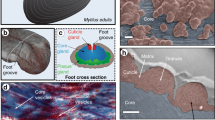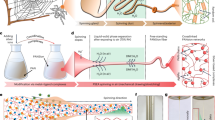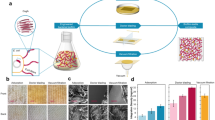Abstract
Formulating effective coatings for use in nano- and biotechnology poses considerable technical challenges1. If they are to provide abrasion resistance, coatings must be hard and adhere well to the underlying substrate2. High hardness, however, comes at the expense of extensibility3,4. This property trade-off makes the design of coatings for even moderately compliant substrates problematic, because substrate deformation easily exceeds the strain limit of the coating5. Although the highest strain capacity of synthetic fibre coatings is less than 10%, deformable coatings are ubiquitous in biological systems3,6. With an eye to heeding the lessons of nature, the cuticular coatings of byssal threads from two species of marine mussels, Mytilus galloprovincialis and Perna canaliculus, have been investigated. Consistent with their function to protect collagenous fibres in the byssal-thread core, these coatings show hardness and stiffness comparable to those of engineering plastics and yet are surprisingly extensible; the tensile failure strain of P. canaliculus cuticle is about 30% and that of M. galloprovincialis is a remarkable 70%. The difference in extensibility is attributable to the presence of deformable microphase-separated granules within the cuticle of M. galloprovincialis. The results have important implications in the design of bio-inspired extensible coatings.
This is a preview of subscription content, access via your institution
Access options
Subscribe to this journal
Receive 12 print issues and online access
$259.00 per year
only $21.58 per issue
Buy this article
- Purchase on Springer Link
- Instant access to full article PDF
Prices may be subject to local taxes which are calculated during checkout




Similar content being viewed by others
References
Ghosh, S. K. in Functional Coatings (ed. Ghosh, S. K.) (Wiley, Weinheim, 2006).
Rossi, S., Deflorian, F. & Risatti, M. Reduction of corrosion protection properties of organic coatings due to abrasive damage produced by natural sands. Wear 261, 922–931 (2006).
Fabbri, P. et al. Cohesive and adhesive properties of polycaprolactone/silica hybrid coatings on poly(methyl methacrylate) substrates. Surf. Coat. Technol. 200, 6706–6712 (2006).
Leyland, A. & Matthews, A. On the significance of the H/E ratio in wear control: A nanocomposite coating approach to optimised tribological behavior. Wear 246, 1–11 (2000).
Messori, M. et al. Prevention of plasticizer leaching from PVC medical devices by using organic–inorganic hybrid coatings. Polymer 45, 805–813 (2004).
Das, D., Datta, M., Chavan, R. B. & Datta, S. K. Coating of jute with natural rubber. J. Appl. Polym. Sci. 98, 484–489 (2005).
Sun, C. & Waite, J. H. Mapping chemical gradients within and along a fibrous structural tissue, mussel byssal threads. J. Biol. Chem. 280, 39332–39336 (2005).
Zhao, H. & Waite, J. H. Coating proteins: Structure and cross-linking in fp-1 from the green shell mussel Perna canaliculis. Biochemistry 44, 15915–15923 (2005).
Rius, M. & McQuaid, C. D. Wave action and competitive interaction between the invasive mussel Mytilus galloprovincialis and the indigenous Perna perna in South Africa. Mar. Biol. 150, 69–78 (2006).
Zardi, G. I., Nicastri, K. R., Porri, F. & McQuaid, C. D. Sand stress as a non-determinant of habitat segregation of indigenous (Perna perna) and invasive (Mytilus galloprovincialis) mussels in South Africa. Mar. Biol. 148, 1031–1038 (2006).
Faul, C. F. J. & Antonnietti, M. Ionic self-assembly: Facile synthesis of supramolecular materials. Adv. Mater. 15, 673–683 (2003).
Unnikrishnan, K. P. & Thachi, E. T. Toughening of epoxy resins. Design. Monomers Polym. 9, 129–152 (2006).
Gao, G., Zhang, J., Yang, H., Zhou, C. & Zhang, H. Deformation mechanisms of polystyrene toughened with sub-micrometer monodisperse rubber particles. Polym. Int. 55, 1215–1221 (2006).
Newman, S. & Strella, S. Stress–strain behavior of rubber-reinforced glassy polymers. J. Appl. Polym. Sci. 9, 2297–2310 (1965).
Inoue, K., Waite, J. H., Matsuoka, M., Odo, S. & Harayama, S. Interspecific variations in adhesive protein sequences of Mytilus edulis, M. galloprovincialis and M. trossulus. Biol. Bull. 189, 370–375 (1995).
Zhao, H. & Waite, J. H. Linking adhesive and structural proteins in the attachment plaque of Mytilus californianus. J. Biol. Chem. 281, 26150–26158 (2006).
Lee, H., Scherer, N. F. & Messersmith, P. B. Single-molecule mechanics of mussel adhesion. Proc. Natl Acad. Sci. USA 103, 12999–13003 (2006).
Zuccarello, L. V. Ultrastructural and cytochemical study on the enzyme gland of the foot of a mollusc. Tissue Cell 13, 701–713 (1981).
Williams, T., Marumo, K., Waite, J. H. & Henkens, R. W. Mussel glue protein has an open conformation. Arch. Biochem. Biophys. 269, 415–422 (1989).
Oliver, W. C. & Pharr, G. M. An improved technique for determining hardness and elastic-modulus using load and displacement sensing indentation experiments. J. Mater. Res. 7, 1564–1583 (1992).
Acknowledgements
The authors thank J. Weaver for continued discussion of this project. This work was supported by the National Institute of Health under awards No. R01 DE015415 and No. R01-GM65354. G.E.F. thanks the Austrian Academy of Science for a DOC fellowship. This work made use of the MRL central facilities at UCSB supported by the MRSEC Program of the National Science Foundation under award No. DMR00-80034.
Author information
Authors and Affiliations
Contributions
G.E.F. and S.H. contributed with experimental work and data analysis. J.H.W. contributed with experimental design, data analysis, manuscript writing and project research management. F.W.Z. contributed with experimental design, data analysis and manuscript writing.
Corresponding authors
Ethics declarations
Competing interests
The authors declare no competing financial interests.
Rights and permissions
About this article
Cite this article
Holten-Andersen, N., Fantner, G., Hohlbauch, S. et al. Protective coatings on extensible biofibres. Nature Mater 6, 669–672 (2007). https://doi.org/10.1038/nmat1956
Received:
Accepted:
Published:
Issue Date:
DOI: https://doi.org/10.1038/nmat1956
This article is cited by
-
Fluid protein condensates for bio-inspired applications
Nature Reviews Bioengineering (2023)
-
Total urinary polyphenols and longitudinal changes of bone properties. The InCHIANTI study
Osteoporosis International (2021)
-
Co-evolving with Nature: The Recent Trends on the Mussel-inspired Polymers in Medical Adhesion
Biotechnology and Bioprocess Engineering (2021)
-
Hierarchically-structured metalloprotein composite coatings biofabricated from co-existing condensed liquid phases
Nature Communications (2020)
-
Stimuli-Responsive Biopolymers: An Inspiration for Synthetic Smart Materials and Their Applications in Self-Controlled Catalysis
Journal of Inorganic and Organometallic Polymers and Materials (2020)



